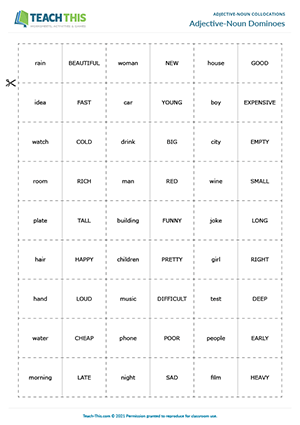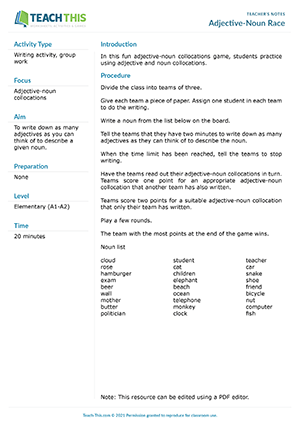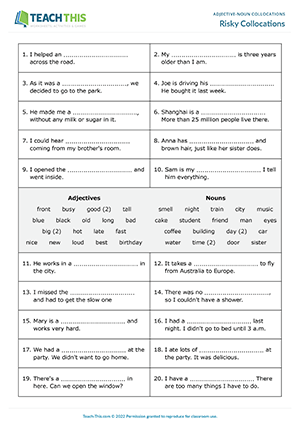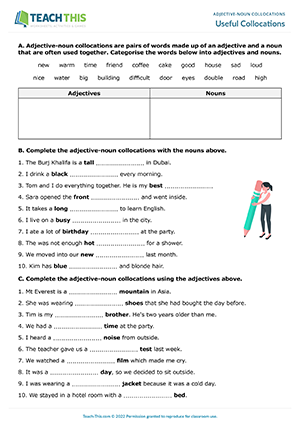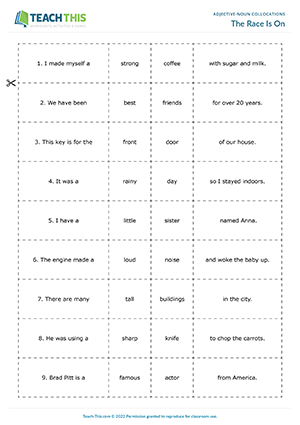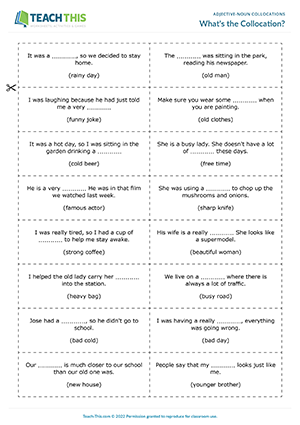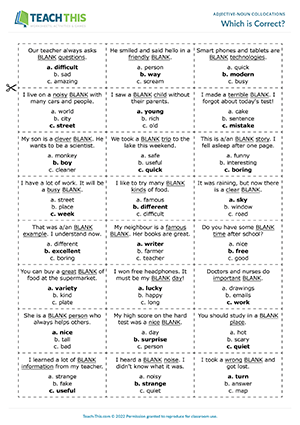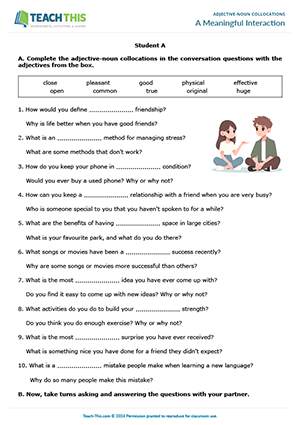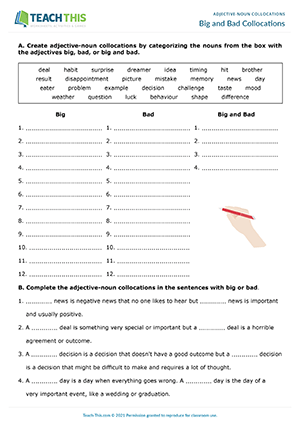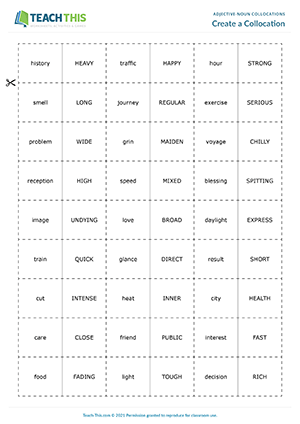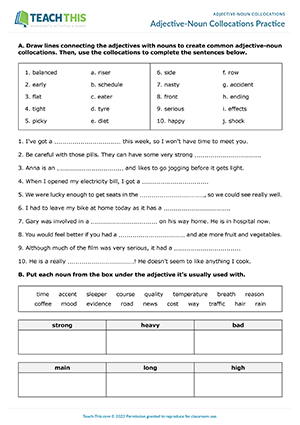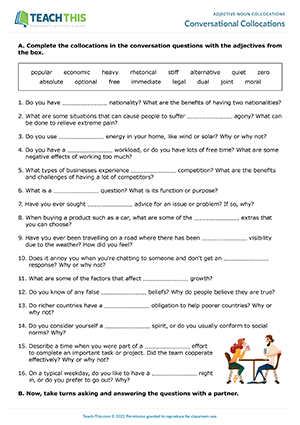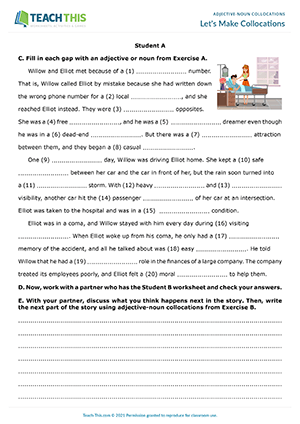Here is a free adjectives and nouns game to help elementary students practice adjective-noun collocations. The first player puts down one of their dominoes on either side of the domino on the table, making sure that the adjective and noun make a suitable collocation. The players then take it in turns to match the adjective and noun collocations by putting their dominoes down at either end of the domino chain. The first player to get rid of all their dominoes wins the game.
In this fun adjective-noun collocations game, students add adjectives to nouns to form adjective-noun collocations. Write a noun on the board. Teams then have two minutes to write down as many adjectives as they can think of that collocate with the noun. After two minutes, teams stop writing. Each teams then reads out their adjective-noun collocations in turn. Teams score one point for an appropriate adjective-noun collocation that another team has also written and two points for collocations that only their team has written. Play a few rounds using a different noun each time. The team with the most points at the end of the game wins.
In this productive adjective-noun collocations game, students complete sentences by matching adjectives and nouns together to form collocations. Teams take it in turns to roll the dice. If a team rolls an odd number, they complete an odd-numbered sentence on the game board and vice versa for an even number. The team then chooses a numbered sentence and completes it with an adjective-noun collocation by matching an adjective and noun from the game board and writing the collocation in the space. When all the sentences have been completed, elicit the correct answers from the class. Teams score one point for each correct answer. The team with the most points wins the game.
Here is a handy adjective-noun collocations worksheet for elementary students. Students start by categorising words into adjectives and nouns. Next, students complete adjective-noun collocations in sentences using the nouns. Students then repeat the exercise, but this time using the adjectives. After that, students match sentence halves together and add a suitable noun to each sentence from the table in Exercise A. Next, students complete sentences using collocations from the previous page. Students then move on to complete conversation questions using adjective-noun collocations from the first page. Lastly, students ask and answer the questions with a partner.
In this rewarding adjective-noun collocations game, students race to form sentences containing adjective-noun collocations. First, in pairs, students match adjective cards with noun cards to form adjective-noun collocations. Students then place sentence beginning cards in order and put a suitable adjective-noun collocation to follow the beginning of each sentence. After that, students complete each sentence with an appropriate ending. The first pair to correctly complete all 18 sentences wins.
In this free adjective-noun collocations game, students race to guess missing collocations in sentences. In groups, students take it in turns to pick up a card and read the sentence on the card using the word 'blank' for the missing adjective-noun collocation. The other students then race to guess the missing adjective-noun collocation from the context of the sentence. The first student to correctly guess the collocation wins and keeps the card. If students are having difficulty guessing, the reader can mime the collocation to help the students get the right answer. The student with the most cards at the end of the game wins.
In this fast-paced adjective-noun collocations game, students race to choose the best adjective or noun to complete adjective-noun collocations in sentences. In groups, students take it in turns to pick up a card, without showing it to anyone. The student then reads out the sentence on the card using the word 'blank' for the missing adjective or noun and then gives three choices for the possible answer. The other group members listen and race to say the adjective or noun that best completes the adjective-noun collocation in the sentence. The first student to say the correct answer wins and keeps the card. Students are allowed one guess per turn. If no one says the correct answer, the card is placed at the bottom of the pile to be used again later in the game. The student with the most cards at the end is the winner.
In this productive adjective-noun collocations speaking activity, students complete, ask and answer conversation questions containing useful adjective-noun collocations. First, in two groups, students complete adjective-noun collocations in conversation questions with adjectives from a box. Students then pair up with someone from the other group and take turns asking the conversation questions to their partner, who responds accordingly. For the first question in each set, students include the corresponding adjective-noun collocation in their response. Afterwards, students share what they learned about their partner with the class.
Here is a useful adjective-noun collocations worksheet to help students learn and practice nouns that are commonly used with the adjectives big and bad. To begin, students create adjective-noun collocations by categorizing nouns from a box with the adjectives big, bad, or big and bad. Next, students complete adjective-noun collocations in sentences with the adjectives big or bad. Students then move on to read sentences and circle the correct adjective to complete each collocation. In the last exercise, students complete adjective-noun collocations in a story with nouns from a box.
In this enjoyable adjective-noun collocations game, students play dominoes by matching adjectives and nouns together to make collocations and then using the collocations in sentences. The first player puts down one of their dominoes on either side of the domino on the table, making sure that the adjective and noun make a suitable collocation. If the player makes an appropriate collocation, they score a point. For an extra point, the player then uses the adjective-noun collocation in a sentence. The other players then take it in turns to match the adjectives and nouns together by putting their dominoes down at either end of the domino chain and making a suitable sentence when a collocation is formed. The game ends when a player has gotten rid of all their dominoes. The player with the most points wins the game.
Here is a comprehensive adjective-noun collocations worksheet for upper-intermediate students. First, students match adjectives with nouns to create adjective-noun collocations and then use them to complete sentences. Next, students put each noun from a box under the adjective it's usually used with. Students then put a tick next to adjective-noun collocations in sentences that are correct. If a collocation is incorrect, students cross them out and write the correct adjective-noun collocation next to the sentence. Lastly, students complete conversation questions with the adjective-noun collocations from the worksheet and then ask and answer the questions with a partner.
In this insightful adjective-noun collocations speaking activity, students complete collocations in conversation questions with adjectives and then discuss the questions with a partner. Working alone or together, students complete collocations in conversation questions with adjectives from a box. Afterwards, check the questions with the class and go over the meaning of each adjective-noun collocation. Next, students take turns asking and answering the conversation questions with a partner. Finally, pairs share their answers with the class.
In this engaging adjective-noun collocations worksheet and pairwork activity, students practice making adjective-noun collocations and using them in stories. Students begin by combining each adjective with a suitable noun from a box on the worksheet to make an adjective-noun collocation. In the next exercise, students think about what other adjective-noun collocations use the same adjectives. Students then add an appropriate noun to each adjective. Next, in pairs, students complete a short story by filling in each gap with an adjective or noun from Exercise A. After that, the pairs discuss what they think happens next in the story. Students then write the next part of the story using adjective-noun collocations from Exercise B. Finally, students read out their stories to the class.
Latest Free
Resources
- Everyday Objects Bingo
Everyday Objects
Elementary (A1-A2)
- Action Verb Races
Actions
Elementary (A1-A2)
- Birthday Basics
Birthdays
Elementary (A1-A2)
- Sales Phrasal Verbs
Business Phrasal Verbs
Upper-intermediate (B2)
Latest Member
Resources
- Collocations at Work
Business Collocations
Intermediate (B1)
- Etiquette Trivia Board Game
Etiquette and Manners
Upper-intermediate (B2)
- Everyday Objects Vocabulary
Everyday Objects
Pre-intermediate (A2)
- Let's have a talk
Verb-Noun Collocations
Pre-intermediate (A2)



